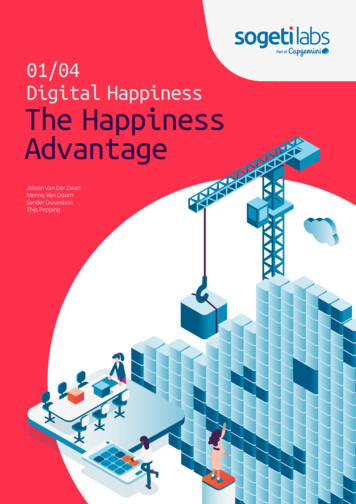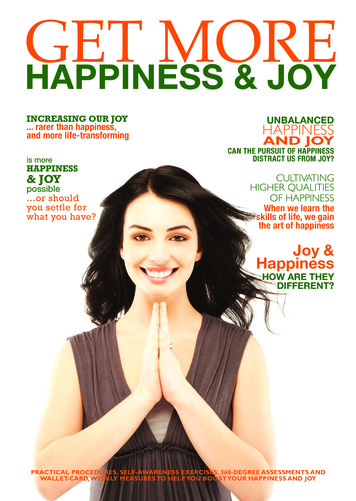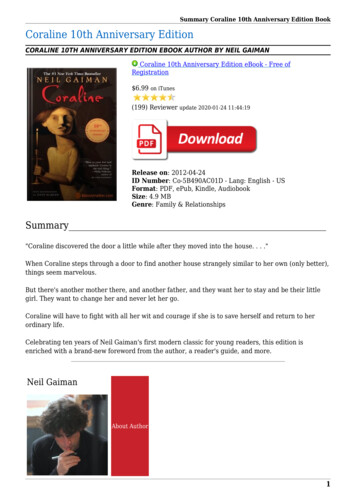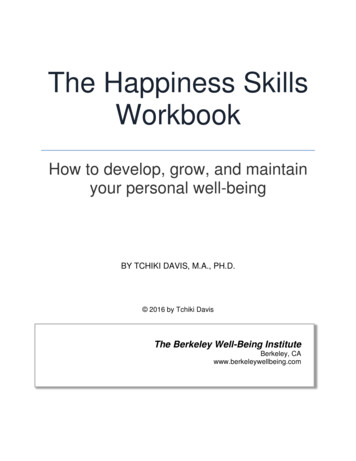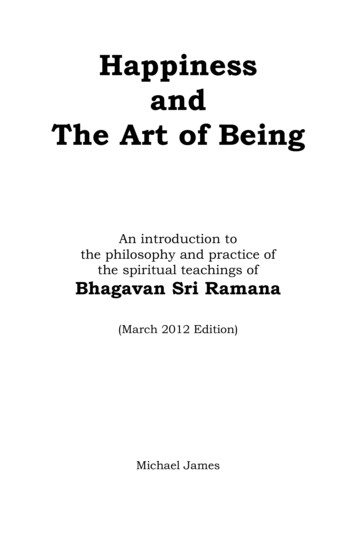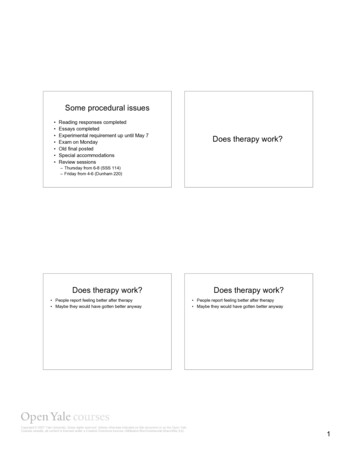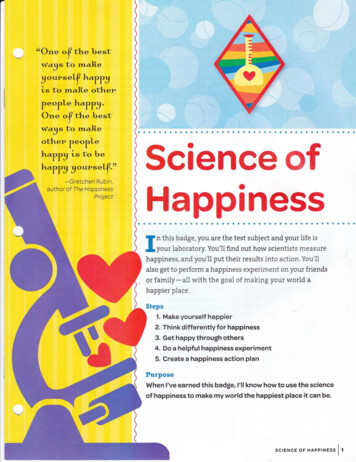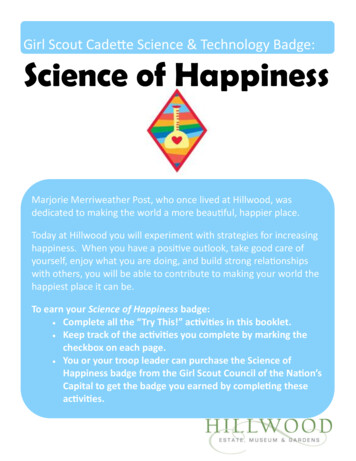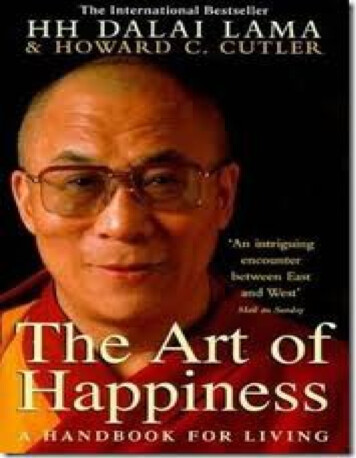
Transcription
Table of ContentsTitle PageCopyright PageDedicationPREFACE TO THE 10TH ANNIVERSARYEDITIONIntroductionPart I - THE PURPOSE OF LIFEChapter 1 - THE RIGHT TO HAPPINESSChapter 2 - THE SOURCES OF HAPPINESSChapter 3 - TRAINING THE MIND FORHAPPINESS
Chapter 4 - RECLAIMING OUR INNATESTATE OF HAPPINESSPart II - HUMAN WARMTH ANDCOMPASSIONChapter 5 - A NEW MODEL FORINTIMACYChapter 6 - DEEPENING OURCONNECTION TO OTHERSChapter 7 - THE VALUE AND BENEFITSOF COMPASSIONPart III - TRANSFORMINGSUFFERING
Chapter 8 - FACING SUFFERINGChapter 9 - SELF-CREATED SUFFERINGChapter 10 - SHIFTING PERSPECTIVEChapter 11 - FINDING MEANING IN PAINAND SUFFERINGPart IV - OVERCOMINGOBSTACLESChapter 12 - BRINGING ABOUT CHANGEChapter 13 - DEALING WITH ANGER ANDHATREDChapter 14 - DEALING WITH ANXIETYAND BUILDING SELF-ESTEEMPart V - CLOSING REFLECTIONS
ON LIVING A SPIRITUAL LIFEChapter 15 - BASIC SPIRITUAL VALUESAcknowledgementsTHE ART OF HAPPINESS BOOK SERIESABOUT THE AUTHORS
RIVERHEAD BOOKSPublished by the Penguin GroupPenguin Group (USA) Inc., 375 Hudson Street, New York,New York 10014,USA Penguin Group (Canada), 90 Eglinton Avenue East,Suite 700, Toronto, OntarioM4P 2Y3, Canada (a division of Pearson Canada Inc.)Penguin Books Ltd, 80 Strand,London WC2R 0RL, England Penguin Ireland, 25 StStephen’s Green, Dublin 2, Ireland(a division of Penguin Books Ltd) Penguin Group (Australia),250 Camberwell Road,Camberwell, Victoria 3124, Australia (a division of PearsonAustralia Group Pty Ltd)Penguin Books India Pvt Ltd, 11 Community Centre,Panchsheel Park, New Delhi-110 017,India Penguin Group (NZ), 67 Apollo Drive, Rosedale, North
Shore 0632, New Zealand(a division of Pearson New Zealand Ltd) Penguin Books(South Africa) (Pty) Ltd,24 Sturdee Avenue, Rosebank, Johannesburg 2196, SouthAfricaPenguin Books Ltd, Registered Offices: 80 Strand, LondonWC2R ORL, EnglandCopyright 1998 by HH Dalai Lama and Howard C. Cutler,M.D.Preface to the 10th Anniversary Edition copyright 2009 byHH Dalai LamaIntroduction to the 10th Anniversary Edition copyright 2009by Howard C. Cutler, M.D.All rights reserved. No part of this book may be reproduced,scanned, or distributed in any printed or electronic formwithout permission. Please do not participate in or encouragepiracy of copyrighted materials in violation of the authors’rights. Purchase only authorized editions. Published
simultaneously in CanadaThe excerpt from “Eight Verses of the Training of the Mind”by Geshe Langri Thangpa on page 182 is from the FourEssential Buddbist Commentaries by His Holiness the DalaiLama. P.), India.Library of Congress Cataloging-in- Publication DataBstan-dzin-rgya-mtsho, Dalai Lama XIV, date.The art of happiness.—10th anniversary ed.p. cm.With a new praface by the Dalai Lama and a new introductionby Howard C. Cutler.eISBN : 978-1-101-13516-71. Religious life—Buddhism. 2. Happiness—Religiousaspects—Buddhism. 3. Buddhism—Doctrines.1. Cutler, Howard C. 11. Title.BQ7935.B774A294.3’444—dc22
While the authors’ had made every effort to provide accuratetelephone numbers and Internet addresses at the time ofpublication, neither the publisher nor the authors’ assumeany responsibility for errors, or for changes that occur afterpublication. Further, the publisher does not have any controlover and does not assume any responsibility for author orthird-party websites or their content.http://us.penguingroup.com
Dedicated to the Reader:May you find happiness.
PREFACE TO THE 10THANNIVERSARY EDITIONby His Holiness the Dalai LamaI am very happy to learn that the publisher ofThe Art of Happiness—which I cowrote withmy old friend, the American psychiatrist HowardCutler—is bringing out a tenth anniversary edition
of the book. Those who have read the book willknow that it was the result of many hours ofdiscussion, with Howard representing the currentscientific perspective and me representing theBuddhist understanding of the issues pertaining tomental health and human well-being. So when thebook was received well by the general public, Ifelt a deep sense of satisfaction since thisindicated that our labor had made somecontribution towards others’ happiness and wellbeing. Though each of us, the two authors, camefrom different perspectives, we alwaysendeavored to bring our discussion to the basichuman level, the level where distinctions betweenpeople—gender, race, religion, culture, andlanguage—break down. At this fundamentallevel, we are all the same; each one of us aspiresto happiness and each one of us does not wish to
suffer. This is our most fundamental reality. Andon this level, the problems that we each face ashuman beings remain the same. Given this belief,whenever I have the opportunity to engage withthe general public, I always try to draw people’sattention to this fundamental sameness of thehuman family and the deeply interconnectednature of our existence and welfare. I also sharemy belief that as a species we need to ground ourinteraction with fellow human beings and theworld around us on recognition of these profoundyet simple truths.Today, a decade after the publication of TheArt of Happiness, I am heartened to see that thetopic of human happiness is attracting increasinglevels of interest and serious research, even fromthe scientific community. There is also a growingrecognition within the wider community, as well
as a growing body of scientific evidence, thatconfirms the close connection that exists betweenour own states of mind and our happiness. Manyyears ago I wrote: “If you want others to behappy practice compassion; and if you wantyourself to be happy practice compassion.” TheBuddhist tradition has, like many of the world’sgreat spiritual traditions, exhorted us to live ourlives compassionately. These spiritual traditionsteach us to feel connected with our fellow beingsand with the world we live in. They celebrateservice to others as one of the highest virtues.Today, growing scientific data confirm thisinsight. Researchers on human happiness identifycompassionate service to others as one of thekey characteristics shared by many of theworld’s happiest people. To me this makesperfect sense. When we help others, the focus of
our mind assumes a broader horizon within whichwe are able to see our own petty problems in amore realistic proportion. What previouslyappeared to be daunting and unbearable, whichis what often makes our problems sooverwhelming, tends to lose its intensity.The question is: Can we cultivate ourselves tobe more compassionate? If so, how do we do it?Again, here I believe that profound recognition ofthe fundamental sameness of the human familyand the deeply interconnected nature of our wellbeing are crucially important. When you feelconnected with others you are able to open yourheart, which I often call our “inner door,” andreach out to others. In doing so, you acquire adeep sense of security and trust and a true senseof freedom. A key element of this process entailscultivating some degree of greater awareness
with respect to one’s own mental states,especially one’s emotions and moods. With thesepractices you can lay a strong foundation withinyou, a kind of anchor that provides a true innerhome. This is the basis of true inner happiness, agenuine wellspring of joy. Researchers oftenwonder about the causal sequence betweencompassion and happiness. They ask: Is it thecase that compassionate people are happier orare happy people more compassionate? On apractical level, I suppose, which comes first doesnot really matter. What matters is that we cancultivate both. In my own Buddhist tradition,numerous mental trainings are offered tosystematically cultivate greater compassion andwell-being. Today, with new insights from thefield of neuroscience, especially with thediscovery of brain plasticity, we know that the
human brain is highly amenable to change andadaptation, even at advanced ages, as in one’sseventies, as I am now. The revered thirteenthcentury Tibetan master Sakya Pandita once said,“Seek learning even if you were to dietomorrow.”In The Art of Happiness, we attempted topresent to the reader a systematic approach toachieving greater happiness and overcoming life’sinevitable adversities and suffering. Our approachcombines and integrates the best of East andWest—that is, Western science and psychologyon the one hand and Buddhist principles andpractices on the other. Our aim has been to sharewith others the conviction that there is a lot eachof us can do to achieve greater happiness in ourlives and, more important, to draw attention tothe tremendous inner resources that are at the
disposal of each of us. Given these central aims,the main approach in this book has been toexplore ways and means towards greaterhappiness and joy in life from the perspective ofan individual human being.Over the last ten years, Howard and I havecontinued our conversations, taking thediscussion to the level of wider society and howthe external environment impacts our happiness.In the course of these conversations we haveexplored a number of the key principles andpractices that can play an important role in one’spersonal quest for happiness. And moreimportant, we have explored some of thechallenging questions pertaining to how one canbest apply these principles and practices in thecontext of the wider society. How can onemaintain happiness in today’s troubled and
challenging world? How can one apply theprinciples of The Art of Happiness in dealingwith problems and suffering in the world? Whatare the roots of violence, on both the individuallevel and the societal level? How can one learn toundo these sources of violence? How can onesustain hope in humanity in the face of humanviolence and suffering? These are a few of thequestions we strove to address in ourdiscussions. During this decade, I have alsocontinued with my ongoing dialogues withscientists, especially from the fields of cognitiveand affective neuroscience as well as psychology,so that a greater convergence could be broughtbetween the age-old insights of my own Buddhisttradition and modern science. I hope the fruits ofthis exploration as well as my ongoingconversations with Howard will evolve into a
new book so that others can share in theseexchanges, which I have personally found deeplyenriching.
INTRODUCTION TO THE10TH ANNIVERSARYEDITIONThe Art of Happiness: Looking Backand Looking Forwardby Howard C. Cutler, M.D.
THE BEGINNINGA full decade has now passed since The Art ofHappiness was first published. As I reflect on thecourse of events leading to the book’spublication, I think back to the beginning of thenineties, when I first conceived of collaboratingwith the Dalai Lama on a book about happiness.The Dalai Lama’s name was familiar to mostAmericans by that time, but beyond the Buddhistcommunity, few had any sense of him as a realhuman being. The general public’s image of himwas often little more than a vague sketchycaricature, marred by misconceptions: the jollygiggling Buddha, “the Pope of Buddhism,” “thegod-king of Tibet.” In fact, if you mentioned theDalai Lama’s name at that time, the most likely
image to surface in the mind of an averageAmerican was probably Carl Spackler, thedisheveled golf course groundskeeper in the filmCaddysback, describing his brief stint as theDalai Lama’s caddy: “. So we finish theeighteenth and he’s gonna stiff me! And I say,‘Hey, Lama! Hey, bow about a littlesomething, you know, for the effort.’ And besays, ‘Oh, uh, there won’t be any money, butwhen you die, on your deathbed, you willreceive total consciousness.’ So I got that goinfor me—which is nice.”Of course, there were some whose mentalportrait of the Dalai Lama was more finelydrawn, those who recognized him as a NobelPeace Prize laureate, a tireless advocate forhuman rights, one who remained committed tononviolence despite living fifty years in exile as a
result of the brutal invasion of Tibet by Chineseforces. But even among the moreknowledgeable, perception of him was oftenone-dimensional-some people saw him asessentially a political figure, for example, unawareof his stature as one of the world’s leadingBuddhist scholars, a teacher with profoundspiritual depth and wisdom. And many people atthat time would have been surprised to learn thatfar from considering himself to be a great worldleader, the Dalai Lama’s personal identity wasmost closely tied to his role as a simple Buddhistmonk—one who rose each morning at 3:30 tospend four or five hours in prayer and meditation.So by the early 1990s, I began to think abouta book that would dispel these misconceptionsand add some human flesh to the cartoonlikeimage of him in the popular imagination. But that
was not the main purpose of the book. The farmore important objective was to present hisideas about how to find happiness.
PUBLICATIONI vividly recall the meeting when I first proposedthe idea of the book to the Dalai Lama. I wasfeeling far from confident. Over the years I hadnoted his skill at deflecting such proposals—so,fully expecting that he would turn down myrequest, I had come prepared, ready to argue mycase.“Your Holiness, I know that you have alreadywritten two dozen books,” I began, “but thisbook will be quite different. The objective is todistill the essential principles that you live by,which have enabled you to achieve a happy life.And even though these underlying principles maybe based on Buddhism, I hope to present yourbeliefs in a way that can be applied by individuals
from any background or tradition, showing howto apply these principles in their daily lives tocultivate greater happiness.”“Ah, very good!” he said with enthusiasm.“And then from my perspective as apsychiatrist,” I continued, “I’d like to examineyour views on happiness, on what makes lifeworthwhile, within the context of Westernpsychology, even looking for scientific evidencethat might support your views.”“Yes. Okay!” the Dalai Lama said decisively,nodding his head in agreement to my proposal.Without taking a breath, I pressed on, drivenby my preconceived belief that he would notreadily agree. My mind was so focused onconvincing him, so intent on dazzling him with myarguments, that I had no attention left over toactually attend to what he was saying or to
register his response.Looking a bit perplexed, the Dalai Lamasuddenly interrupted me.“Howard,” he said, starting to laugh, “Ialready agreed. Why are you still arguing thecase?”Finally grasping that he had agreed to myproposal, I felt a surge of elation—among myobjectives and reasons for proposing this book,there was a more selfish motive that I hadconveniently forgotten to mention: I wanted tolearn from him how I myself could becomehappier.We began work on the book in 1993, duringthe Dalai Lama’s first visit to Arizona, my homestate. That week he had an intensive teachingschedule, delivering a brilliant commentary on aclassic text by Shantideva, the great eighth-
century Indian Buddhist scholar. Despite his longdaily teaching sessions, we managed to carve outsome time to meet, aided by the fact that he wasstaying at the same place where his publicteachings were being given, a resort hotel in theSonoran Desert, outside Tucson. So everymorning after breakfast, and in some lateafternoons as well, we met in his suite, as I posedquestion after question, soliciting his views aboutlife, about the things that truly make lifeworthwhile, the vital questions related to humanhappiness and suffering.Over the months prior to our conversations, Ihad spent a great deal of time preparing a list ofquestions, carefully arranging their sequenceaccording to a tightly organized outline that filleda thick three-ring binder. So when I showed upfor our first meeting, I was ready. And it took
only minutes for the Dalai Lama to relieve me ofany illusions I might have had about controllingthe direction of the discussion. I had planned onsticking with my set agenda in an orderly fashion,breezing through the questions one by one likeknocking down a row of dominoes. But I quicklydiscovered that he apparently felt no compulsionto follow my agenda. His answers to myquestions were often unanticipated, suddenlyturning the conversation in a completely newdirection. I might be following a certain train ofthought, when suddenly that train would becomederailed as he went off on an unexpected tangent.So I found our discussions to be challenging attimes. At the same time, the Dalai Lama’s quickmind and robust sense of humor kept theconversations lively, and riveted my attentionthroughout.
Those conversations, supplemented withmaterial from his public talks, provided the corematerial for the book, which was later expandedby additional discussions at his home in India.Quickly becoming absorbed in the project, Idecided to temporarily give up practicingpsychiatry in order to devote my full attention toexploring human happiness, seeking an approachthat bridged East and West. I estimated that itwould take perhaps six months to complete thebook, and with the Dalai Lama as a coauthor, Ifigured that finding a publisher would be easy.As it turned out, I was wrong. Five yearslater, I was still working on the book. And thethick stack of rejection letters accumulating onmy desk from literary agents and publishers wasa growing testament to the prevailing wisdom inthe publishing industry at that time: the belief that
books by the Dalai Lama held no appeal to amainstream audience. In addition, they claimed,the public simply didn’t seem to be interested inthe topic of human happiness.By 1998, after years of continual rejections,and with my financial resources finally depleted, itseemed I had few options left. Still, determinedto see that at least a few new readers couldbenefit from the Dalai Lama’s wisdom, I plannedto use the last of my retirement savings to selfpublish a small number of copies. Strangely,however, it was right at that point that the motherof a close friend happened to make an offhandremark to a stranger on a New York subway—astranger who turned out to be in the publishingindustry—which initiated a series of connectionsthat finally led to agreements with both a literaryagent and a good mainstream publisher. And so,
with a small first printing and modestexpectations, the book was at last released.
UNEXPECTED SUCCESSThat was ten years ago. And the Dalai Lama, thepublisher, and I could never have imagined thesubsequent course of events. Awareness of thebook grew rapidly, spreading more by word ofmouth than by advertising or publicity. Notexpecting such an overwhelmingly positiveresponse, I watched with wonder as the booksoon appeared on the New York Timesbestsellers list, where it remained for the next twoyears. It wasn’t long before we started to seeevidence that the book was truly becoming partof the cultural milieu in America, spontaneouslyshowing up on TV sitcoms, game shows, evenMTV—the very icons of popular culture inAmerica at the time: Friends, Sex and the City,
Jeopardy!, Who Wants to Be a Millionaire,MTV Cribs—and even the season’s openinggame on Monday Night Football, when one ofthe quarterbacks attributed his preseasonsuccess, in part at least, to The Art ofHappiness.Clearly, there was a kind of universal appealto the Dalai Lama’s basic message: Yes,happiness is possible—in fact, we can train inhappiness in much the same way that we trainin any other skill,directly cultivating it through effort andpractice. Explaining how happiness can beachieved by reshaping our attitudes and outlook,the Dalai Lama shows us how the key tohappiness is in our own hands. No longer do weneed to rely on luck or chance to achievehappiness, waiting for the day when all the outer
conditions of our lives finally fall into place—theday we finally lose weight, get rich, get married(or divorced!), or get that coveted promotion.His fundamental message of hope seemed tostrike a chord in people, resonating deep in thehearts of individuals not only in America butthroughout the world—people from diversebackgrounds, perhaps, but who all shared thefundamental human aspiration for happiness, ayearning for something better in life. Ultimately,the book went on to be translated into fiftylanguages and was read by millions around theworld.
A HAPPINESS REVOLUTIONThe concept of happiness as an achievable goal,something we can deliberately cultivate throughpractice and effort, is fundamental to theBuddhist view of happiness. In fact, the idea oftraining the mind has been the cornerstone ofBuddhist practice for millennia. Coincidentally,shortly after the publication of The Art ofHappiness, this same idea began to take root insociety from another direction—as a “new”scientific discovery—leading to a fundamentalshift in many people’s perception of happiness.When I first began work on The Art ofHappiness in the early 1990s, I discovered thatthere were relatively few scientific studies onhappiness and positive emotions. These were not
popular subjects for research. Although at thetime there were a handful of researchers studyinghuman happiness and positive emotions, theywere the mavericks. But then, suddenly, humanhappiness started to become a subject of intenseinterest to the scientific community and thegeneral public alike, as people began to abandontheir previous notions of happiness as elusive,mysterious, and unpredictable, replacing thatview with the perception of happiness assomething that could be scientifically investigated.And over the past decade, as more and morepeople have rejected the idea of happiness assomething that is merely a by-product of ourexternal circumstances, in favor of seeinghappiness as something that can be systematicallydeveloped, we have witnessed the exponentialgrowth of a new movement—a Happiness
Revolution.The watershed event for this new movementwas the formal establishment of a new field ofpsychology involving the study of humanhappiness. The formal birth of this new branch ofpsychology took place in 1998, when a highlyinfluential psychologist, Dr. Martin Seligman, thenewly elected president of the AmericanPsychological Association, decided to dedicatehis term as president to the establishment of thisnew field, which he dubbed “positivepsychology.” Pointing out that for the past halfcentury clinical psychology had focusedexclusively on mental illness, human weakness,and dysfunction, he called on his colleagues toexpand the scope of psychology to include thestudy of positive emotions, human strengths, and“what makes life worth living.”
Seligman teamed up with another brilliantresearcher, Mihaly Csikszentmihalyi, to lay thegroundwork for this new field. They were soonjoined by a core group of top researchers fromuniversities in America and Europe, and positivepsychology took off with tremendous momentum.For the first time in human history, happinesshad finally become a legitimate field ofscientific inquiry.Since that time, the Happiness Revolution hashad a growing impact on all levels of society.Feature stories on happiness have inundated thepopular media, while academic courses onpositive psychology have been cropping up oncollege campuses across the United States andthroughout the world. At Harvard University, forinstance, “The Happiness Course” has nowreplaced Introductory Economics as the most
popular undergraduate course, with enrollmentquickly soaring to well over 1,400 students eachsemester. The impact is even being seen on thegovernmental level in nations around the world,with the country of Bhutan, for instance, replacingGDP with GNH (Gross National Happiness) asits most important measure of success as anation. Policymakers in many nations are noweven exploring the idea of shaping public policybased on happiness research. As onegovernment official in Scotland exuberantlyasserted, “If we can embrace this new science ofpositive psychology, we have the opportunity tocreate a new Enlightenment.”
THE BENEFITS OF HAPPINESSOne of the factors fueling the HappinessRevolution has been the startling research in thepast decade revealing the many benefits ofhappiness, benefits extending far beyond merely“feeling good.” In fact, cultivating greaterhappiness can be seen as “one-stop shopping”for those seeking greater success in every majorlife domain. Scientific studies have shown thathappy people are more likely to attract a mate,enjoy stronger and more satisfying marriages, andare better parents. Happy people are alsohealthier, with better immune function and lesscardiovascular disease. There is even evidencethat happy individuals live up to ten years longerthan their less happy peers! In addition,
happiness leads to better mental health, greaterresilience, and an increased capacity to deal withadversity and trauma.There are some who believe that happypeople tend to be shallow and a bit stupid, anotion shared by the French novelist GustaveFlaubert, who once wrote: “To be stupid, selfish,and have good health are three requirements forhappiness, though if stupidity is lacking, all islost.” Recent research, however, has proven thisidea to be nothing but a myth, finding thathappiness leads to greater creativity andimproved mental functioning.The benefits of happiness extend to theworkplace, as well, with happy individualsperforming better and enjoying greater personalsuccess on every level, including higher income.In fact, studies show that higher income is more
directly related to one’s level of happiness than toone’s level of education. Extensive research hasalso shown that organizations with happyemployees are more successful, consistentlydemonstrating greater profitability; this isn’tsurprising considering that happy workers aremore productive, more loyal to the company,take fewer sick days, show up to work moreconsistently, have fewer conflicts withcoworkers, quit their jobs less frequently, andgenerate greater customer satisfaction.So there is no question that happiness bringstremendous personal rewards. But it is alsocritical to point out that cultivating greaterhappiness benefits not only oneself, but alsoone’s family, community,and society In fact, this is one of the keyprinciples underlying The Art of Happiness, a
principle supported by a growing body ofscientific evidence. For example, a stunningrecent study has shown that happiness is highlycontagious, spreading in social networks just likea virus. Other lines of evidence have found thathappiness and positive emotions act as anantidote to prejudice, causing changes in thebrain that prevent the instinctual bias againstthose we perceive as different, ultimatelybreaking down the barriers between Us andThem! The beneficial effects of happiness extendto the broadest level of society; another study,for instance, found that increasing the averagelevel of happiness among the population of anation will result in an increase in freedom anddemocracy in that country!The Happiness Revolution has led increasingnumbers of individuals to seek happiness in a
more systematic and direct way. There havebeen some critics of the positive psychologymovement who have characterized their efforts asbeing nothing more than a self-absorbed, selfindulgent luxury, concerned only with personalgratification. In view of the above evidence,however, it could be argued that if you are trulyconcerned about the welfare of others andbuilding a better world, it is your duty to behappy, or to do what you can to becomehappier.
BUDDHIST WISDOM ANDMODERN SCIENCE: BRIDGINGEAST AND WESTThe coming of Buddhism to the West may well proveto be the most important event of the TwentiethCentury.—The influential British historian Arnold J.ToynbeeOne of the goals of The Art of Happiness is topresent an approach to achieving human
happiness that combines the best of East andWest, integrating traditional Buddhist wisdomwith modern Western science. Following a recenttalk in which I spoke about this approach, anaudience member asked:“If scientists have conducted research onhappiness and studies have now proven how tobecome happy, what do we need the Buddhisttheories or the Dalai Lama’s views for?Shouldn’t the scientific proof be enough?”Good questions. And as a great admirer ofthe scientific approach to happiness, I think it issafe to say that the checks and balances of thescientific method generally result in highly reliableand useful information. At the same time,however, all scientific findings are not some kindof Absolute Truth or Eternal Law. Scientificknowledge is a dynamic, living thing—and
scientific theories are always being refined,modified, or revised as we gather new data. Andin evaluating the validity of any study, there’salways the possibility of methodological errors,flaws in experimental design, statistical analysis,and so on. One also needs to consider how manysubjects were studied and whether the study hasbeen replicated. With this in mind, it’s importantto recognize that the science of human happinessis still in its infancy. While we have learned agreat deal, there is a lot that we still don’t know.The key question is: Does Buddhism haveanything to contribute to the scientificinvestigation of happiness?In considering this question, it is important tounderstand that Buddhism is not a faith-basedsystem in the traditional sense. In fact, when theBuddha first began to teach, he advised his
disciples not to blindly accept his teachings out offaith, but rather to investigate the validity of histheories and test his methods for themselves. Thisreliance on empirical investigation, theuncompromising commitment to truth, and a totaldedication to discovering the nature of reality arethings that both Buddhism and science have incommon. In fact, the Dalai Lama hasdemonstrated his total commitment to theseprinciples, stating, “If science was to conclusivelyprove that some part of the Buddhist
Essential Buddbist Commentaries by His Holiness the Dalai Lama. P.), India. Library of Congress Cataloging-in- Publication Data Bstan-dzin-rgya-mtsho, Dalai Lama XIV, date. The art of happiness.—10th anniversary ed. p. cm. With a new praface by the Dalai Lama and a new intro
